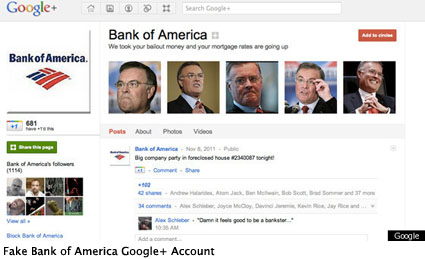Fake Google+ Profile Looks Bad For Bank Of America, But Worse For Google
Huffington Post
November 16, 2011
A Google+ account titled “Bank of America“ posted a series of updates last week mocking homeowners who couldn”™t pay their mortgages.
“Big company party in foreclosed house #2340087 tonight!” read one post.
Another warned Occupy Wall street protesters, “You will sit down and shut up, or we will foreclose on you.”
The Google+ profile featured a Bank of America logo, a link to the bank”™s website, and the address and phone number of its New York headquarters. And though it boasted the same name as Bank of America”™s official page — it was a fake.
Bank of America is one of several high-profile brands, including Disney, that have had their identities usurped on Google+ by users impersonating the companies.
The flap makes Bank of America look bad — but it makes Google look far worse.
BofA’s fake profile marks the latest in a series of stumbles Google has taken while trying to breathe life into Google+, its Facebook competitor, and woo businesses back onto the service after booting them just weeks after the site”™s launch in June.
Google+ is hardly the first social network forced to grapple with parody accounts linked with household brands. Recall, for example, the popularity of the fake “BP Public Relations” account on Twitter, which tweeted snide comments about dead sea-life and the BP oil spill.
And the issue is a thorny one for web companies, who can find themselves swamped with complaints over content on their platforms and policing millions of users. But Google+ is also not the first social network, and it has had years to watch and learn from other firms’ mistakes. But the company seems caught off guard while confronting with the problems that have plagued other social media sites for nearly a decade. The web giant’s string of missteps with Google+, forgivable for a startup, are problematic for a company of its size and stature, say experts, who warn Google risks alienating brands from its service at a time when it needs them most.
“When it comes to launching Google+ and getting brands excited, they’ve dropped the ball. They’ll need to do damage control,” said Shama Kabani, CEO of The Marketing Zen Group, a digital marketing firm. “It all seems very haphazard. You expect more from Google, a company at their level.”
Google+ has had a rocky relationship with brands since its debut. At first, businesses jumped at the opportunity to set up shop on Google+. The Internet giant responded by deleting brand pages seemingly at random, allowing some to stay on for days, while other profiles were pulled almost immediately. It took Google months to launch its official brand pages, and now it appears Google+ lacks an adequate way to cope with online imposters hijacking businesses”™ identities. At the same time, however, Google launched a crackdown on profiles created under fake names or nicknames, deleting many users’ accounts in a move that sparked outrage online. Google’s scrutiny of pseudonyms seems at odds with the fake brand pages that have been allowed to stay.
The launch of Google+ “felt like the way Google rolls out lots of products — throw it out there and modify on the fly,” said Christopher Barcelona, the executive creative director of Resource Interactive. “I think the stakes in this particular instance are too high not to be more strategic in this roll out.”
Google removed the fake Bank of America page on Tuesday, though not before it had posted updates for a full week, accumulating over 1,200 followers — more than 10 times the number following the official Bank of America account.
Read the rest of this article here.

